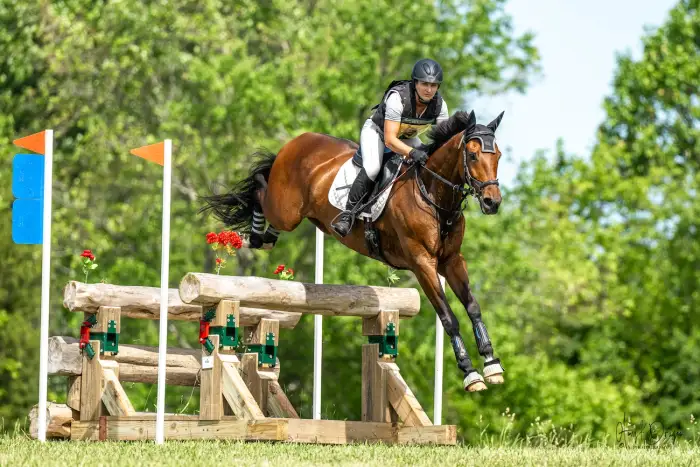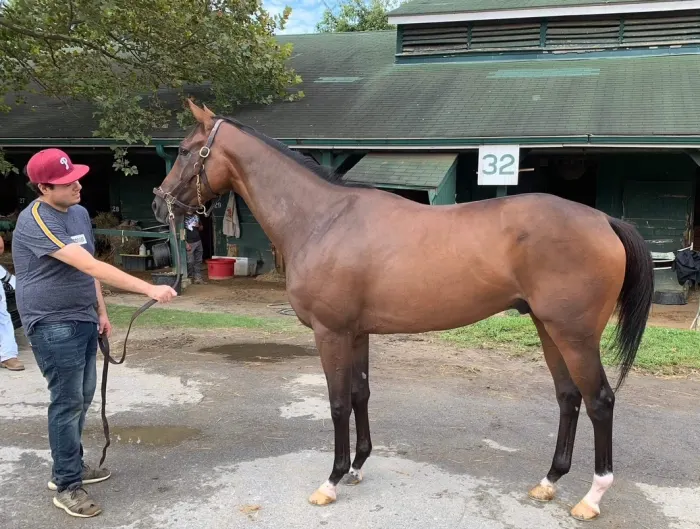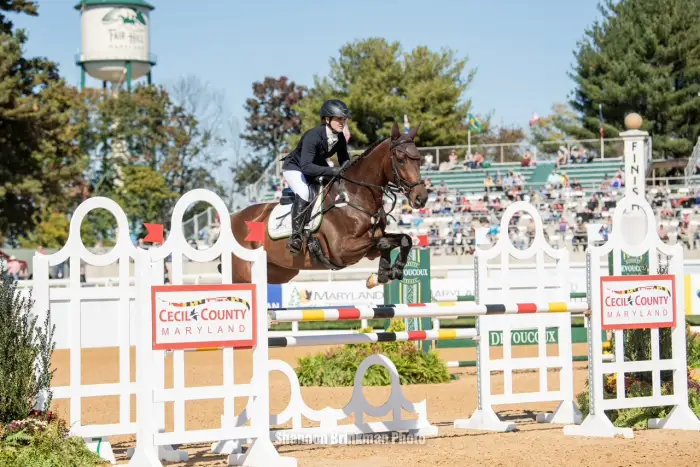It wasn’t until Tracey Bienemann was wrapping up a full day of riding three horses at the Fair Hill International Recognized Horse Trials in Elkton, Maryland, on May 17 that her groom Alyssa Matthews nonchalantly told her how she finished in the advanced division aboard Venezuelan River: “By the way, you won.”
“I’m like, ‘You’re kidding; there’s no way I won. What are you talking about? I had a rail, I had a conservative [dressage] test. That’s crazy!’ ” Bienemann, 35, of Lothian, Maryland, recalled. “So yeah, it was very cool, very surprising. And it might be the first advanced win I’ve had, because I’ve been in the top bunch plenty of times over the many years. But I’m not sure I’ve ever won an advanced.”

The pair topped a division of seven at the soggy event, which was just “Newt’s” second start at the advanced level. They were sixth after dressage with a 37.7, and Bienemann found herself wishing she had pressed for more brilliance. “I came out of the ring, and I was talking to [Matthews] about how pleasant the test was but not flashy. And I was like, ‘Well, you know, I need to be able to ride a winning test, not just a pleasant test.’ So it was an ironic day to pick up a win,” she said.
Newt also lost two front shoes in show jumping and got those hastily tacked back on before heading out to jump clear cross-country with the fastest ride of the day, adding just 6.4 time penalties—and losing one more shoe—on the muddy track.
“He went out on cross-country and just tore it up, piece of cake. Didn’t mind the mud. We had one little blip … I may have almost fallen off in the first water,” she said with a chuckle. “It was very close to a pretty good swim, but the rest of it was much better, I swear!”
It’s an outcome that might have been hard for Bienemann to envision in the early days of her partnership with the quirky off-track Thoroughbred (Mucho Macho Man—Shehaseyesforyou, Is It True), whom she brought home as a 3-year-old in 2019 on the suggestion of an old Pony Club friend, racing trainer Jacqueline Savoye.
“[She] randomly Facebooked me a picture and said, ‘I have this acquaintance. He’s got this horse. He’s free. Do you want him?’ And I was like, ‘Yeah, sure. I’ll go get him Tuesday,’ ” Bienemann said. “So I went over with my dollar and my little two-horse trailer to Delaware Park and scooped him up.
ADVERTISEMENT
“They seemed pleased to be rid of him,” she added wryly. “I did have them jog him for me first, just in case.”
Newt didn’t look like much, Bienemann admits. In the photo Savoye sent, “He kind of looks like a pony. He’s got no tail, he’s got this really round rump. He’s a little bit croup-high, definitely not what you’d picture as a future four-star horse,” she said. “But sure enough, he came home and his first couple rides, he was exceptional. I was like, ‘Wow, this horse is so cool. He’s so simple, he’s so easy.’ But then some of his quirks started to come out. By ride five, he had developed, or probably already had, a very serious, dangerous rearing problem.”

Bienemann said when he’d start rearing, they’d get stuck in a corner of the arena and would need someone come lead them out. For the first year and a half, she wore an air vest whenever she rode him. She didn’t take him on hacks, because if the rearing started out on a trail, she’d be trapped. At his first few starter events, her groom (and Newt’s “emotional support human”) Katherine Holzrichter would have to lead them around the warm-up a few times, then later lead them from the warm-up to the arena or start box. Bienemann didn’t dare enter a recognized competition with him until she’d had him three years.
“It was quite a production, figuring out how to work with his little mental quirks, and he’s still very quirky,” she said. “I wish I could say he has grown out of it, but that horse is still in there.
“Sometimes in these bigger atmospheres, I have to be really conscious of where I warm him up and how I get him from the warm-up to the ring,” she continued. “I have to make sure he doesn’t get a really good look at the crowds or anything. He can get very, very upset, very easily. He’s been an adventure, that’s for sure.”
The key to overcoming Newt’s quirks was mostly time and building a partnership, Bienemann said. “A lot of it was just building confidence, building the toolbox on him. Like, what does leg mean? What does connection mean? How can we function together in a forward direction and not a backward or upward direction?” she said.
She would even take him along to big events where she was competing her other horses, like the Kentucky Three-Day Event and the USEA American Eventing Championships, just for the additional exposure.
ADVERTISEMENT
“Lots of schooling shows, as much exposure as I could take him on to try to get him comfortable in the atmosphere,” she said. “That was, of course, once I started being brave enough to really take him places!”

While Newt’s eventing journey was a little slow to get off the ground—he did his first novice as a 6-year-old in 2022—he and Bienemann had built so much confidence in each other that he moved up relatively quickly through training level and preliminary.
“I don’t always assume, even if a horse is very scopey or very fancy, that they’re going to really make it to the top levels, because it takes such an exceptional amount of grit, and you don’t always know if they’re going to have that until you get out on one of those bigger courses,” Bienemann said. “The first time I felt him really blossom was probably last fall at the Maryland 5 Star [where they competed in the CCI3*-L]. That course was eating people alive, and I had a tough go of it on my other one, Menlo Park. We got around it, but man, it was tough, and ‘Melon’ was the more experienced of the two. But [Newt] went around that like a walk in the park. And it was like, oh gosh, there’s a lot more in here. That was probably the moment it was like, this is the real deal.”
Bienemann said that Newt is quite talented in the dressage, especially for a Thoroughbred, and she believes that he can be competitive at the upper levels, even against the warmbloods. But in both dressage and show jumping, he can struggle a bit with tension.
“His biggest weakness right now is probably in the stadium jumping, because he’s super scopey, but he’s got a very elongated stride and sort of a deeper-necked way of going,” she said. “The show jumping is tough for him because I’ve got to really be able to keep him uphill and balanced while not losing the stride length. And he likes to jump very across and not a whole lot up. So the show jumping has been our toughest phase.”
The next outing Bienemann has planned for Newt is the Bromont International CCI4*-S (Quebec) in June, and she hopes to possibly tackle a four-star long later this year and see just how far her “free” Thoroughbred can go.
“I really want horses like Newt to inspire people to keep bringing Thoroughbreds out for the upper levels,” she said. “It’s faded out so much because people think that they can’t be competitive on the flat and they think that their tension level is going to be too high to jump clean on a Sunday, you know, but with the right training and the confidence and the time invested, there’s nothing else I’d want to sit on, that’s for sure.”














